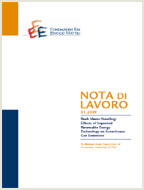Informing the Financing of Universal Energy Access: An Assessment of Current Flows

21.06.2011
Morgan Bazilian, Patrick Nussbaumer, Giorgio Gualberti, Erik Haites, Michael Levi, Judy Siegel, Daniel M. Kammen, Joergen Fenhann
Q4
Energy Access, Energy Finance, Financial flows
Energy: Resources and Markets
Giuseppe Sammarco
Energy poverty is widely recognized as a major obstacle to economic and social development and poverty alleviation. To help inform the design of appropriate and effective policies to reduce energy poverty, we present a brief analysis of the current macro financial flows in the electricity and gas distribution sectors in developing countries. We build on the methodology used to quantify the flows of investment in the climate change area. This methodology relies on national gross fixed capital formation, overseas development assistance, and foreign direct investment. These high-level and aggregated investment figures provide a sense of scale to policy-makers, but are only a small part of the information required to design financial vehicles. In addition, these figures tend to mask numerous variations between sectors and countries, as well as trends and other temporal fluctuations. Nonetheless, for the poorest countries, one can conclude that the current flows are considerably short (at least five times) of what will be required to provide a basic level of access to clean, modern energy services to the “energy poor”.
